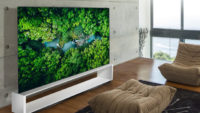CTA, Experts Predict Factors Impacting 8K Display Adoption
November 30, 2020
Seventy-five percent of the market for new television displays is for 4K. While the 1080p format loses ground, 8K sales are growing, expected to be the No. 2 most popular TV display format within the next few years. The 8K resolution format is gaining popularity due to its ability to display complex video game graphics and enable glasses-free 3D and volumetric images integrated with UHD. As the format continues its growth, 8K will depend on upconverting existing 4K content; its integration into NextGen TV (ATSC 3.0) is still ongoing.
At CTA, vice president of market research Steve Koenig pointed out that, “8K’s early growth will be in big screen sets,” adding that, “by 2024, half of the sales for 65-inch and larger displays will be 8K, and that share will increase.” Currently manufacturers of 8K sets only have 65-inch or larger displays on the market.

“Consumers typically want the biggest screen possible,” he explained. “8K faces considerable price competition from 4K UHD sets in similar size segments in the next year or two.”
CTA’s U.S. Consumer Technology Forecast revealed that sales of flat panels boomed at the beginning of the pandemic, meaning “a replacement set (possibly 8K) will be delayed.” The CTA forecast also predicted “the wholesale prices of 8K sets will drop by about half in the next three years, following the trend of previous HDTV and 4K devices in their first years of widespread distribution.”
The CTA’s “average wholesale price prediction of 8K displays in 2023 is about $1,500.”
Then there’s the need for 8K content. At USC’s Entertainment Technology Center, our colleague Phil Lelyveld, who leads the Immersive Media Initiative Program, believes we’ll see growth in 8K content, since it is especially “useful for exploration of images or any sort of reality programming.”
“Resolution of the source material is both something you see and an opportunity to explore,” he said. “For game-engine real-time-rendered content, the possibilities are infinite.” Further, he noted that 5G wireless delivery will boost adoption of 8K and “other higher resolution formats … including AR and VR, which [don’t] have a resolution limit.”
How to distribute 8K content is “one major factor affecting the adoption of 8K displays.” In addition to upconverting DVDs and other packaged programming, video game consoles such as Sony PlayStation 5 and Microsoft Xbox Series X are on track to output 8K graphics this year.
The specs for NextGen TV do not specifically include 8K signals yet, but Advanced Television Systems Committee (ATSC) president Madeleine Noland reported that, “ATSC’s Planning Team 4 encouraged ‘evolvability’ to facilitate the launch of future video technologies … [and] encourages ‘all stakeholders in the broadcast ecosystem to contemplate and identify additional aspects of industry evolution’.”
Among TV manufactures that have shown “prototype or early production 8K sets at CES during the past few years” are Haier, Hisense, LG Electronics, Samsung and Sony. AU Optronics, Panasonic, TCL and Vizio are developing 8K displays.

No Comments Yet
You can be the first to comment!
Sorry, comments for this entry are closed at this time.